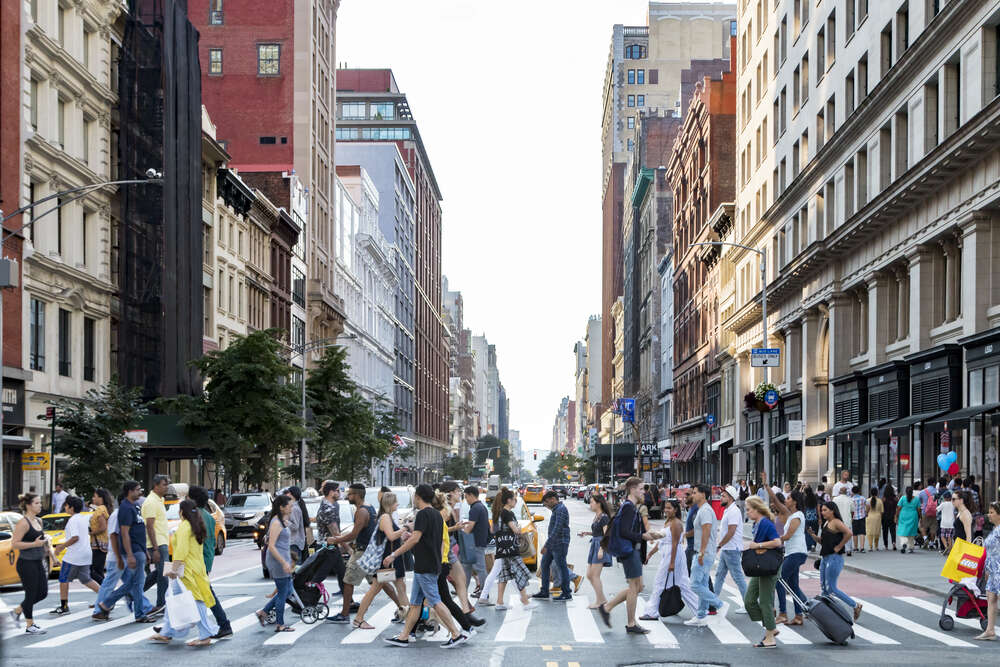
Newly released data from the US census shows that America’s record low population growth between summer 2020 and summer 2021 was driven by a significant decline in the country’s population of white people.

Between July 2020 and July 2021, the population of the US only grew by 0.1%, the lowest since the nation was founded. Analysis of the latest data, conducted by the Brookings Institute, found that as the coronavirus pandemic raged, the white population of the US declined by almost 900,000, while the non-white populations of the US grew.
During the pandemic, births declined while deaths rose sharply, and there was a significant decrease in immigration levels, down to its lowest point in years. The pandemic also prompted a lot of movement within the country, with many people opting to move away from the country’s largest metro areas.
How did the pandemic change the US population?
Across the US, the overall population grew by 392,665 between July 2020 and July 2021, but this hides a huge amount of ethnic variation. In fact, the white population in the US declined by almost 880,000, while the latino/hispanic population grew by 768,000, the Asian-American population by 195,000, and the black population by 133,000.
But while the entire population of the country grew, the population of the country’s largest cities (the 56 metro areas with populations of over one million) fell by 300,000. Smaller cities grew in population significantly, while non-metro areas grew by 115,000.
White people overwhelmingly drove the city exodus in the year to July 2021: the number living in major metro areas fell by over 900,000, while the other major ethnic groups increased their city populations.
Is the US getting more racially diverse?
But this trend isn’t entirely driven by the pandemic: major city population growth has been slowing across all ethnic groups since 2016, except for white people, which have been falling by larger numbers each year.
As the white population is ageing, there have been fewer white births than white deaths since 2013, and this trend is projected to continue to grow, only exacerbated by the pandemic in 2020/21.
In fact, the report writes, 2020 was not the first year that non-white population growth accounted for the population growth of the whole of the US – that began in 2016.
“While these trends are exaggerated in the prime pandemic year, it is plain to see that the nation is facing a long-term transition toward greater diversity and ageing, both nationally and across large swaths of the country,” the report states.
In the early 2010s, the country’s major metro areas experienced high growth, but that growth has been slowing since 2016, and their white populations have in fact been declining.
Between July 2016 and July 2021, the US’ major metro areas' total population grew by 4.2 million. Over half of that is driven by growth in the Latino and hispanic communities of those cities, while the white population has fallen by over 900,000.
The biggest population shifts among US cities
The pandemic caused a seismic shift to these trends, as people left cities not only due to health fears but also to the changing labour markets and boom of remote working, leading to more opportunities in other locations.
In fact, among the country’s 56 major metro areas with a population over one million, 43 saw their white population decline, 16 saw their black population fall, and six saw declines in their Asian-American and Latino or hispanic populations.
The greater New York area saw the biggest fall, with its population declining by 328,000 between July 2020 and July 2021. Over two-thirds of this outward migration is of white people, but all ethnicities saw their New York population decline.
In contrast, southern cities like Dallas, Houston and Austin in Texas, as well as cities in Arizona, Florida, Georgia and North Carolina, all saw their populations grow by over 30,000 in a year.
However, the report makes it clear that much of the pandemic’s impact on populations is only temporary: death rates will fall and mortality age will rise. Immigration will restart and many have already begun to return to the cities. But the growing diversity of the nation is an ongoing trend, as the population of people identifying with two or more ethnicities continues to grow rapidly, and migration into and across the US continues.
[Read more: Reshaping the DNA of residential communities post-pandemic]






